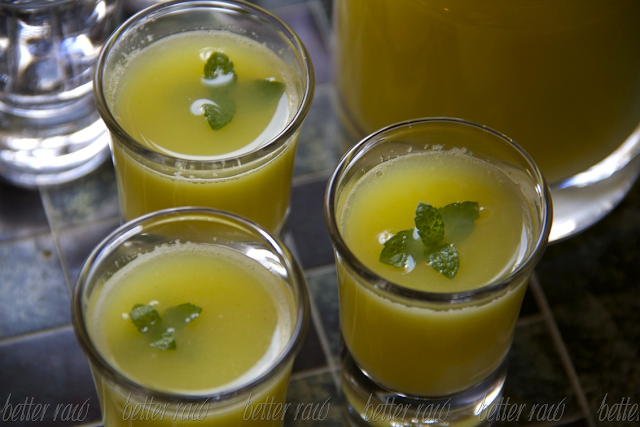top five benefits of chia seeds and apple cinnamon chia pudding recipe
Chia. Chia. Chia. Even the name sounds cheeky and sweet. Oh how I've been looking forward to telling you all about this wonder superfood of them all! And Raw Living couldn't have summed it up any better...
Chia seeds are one of the most powerful, functional, and nutritious superfoods in the world! The chia seed is an excellent source of fiber, packed with antioxidants, full of protein, loaded with vitamins and minerals, and the richest known plant source of omega-3 fatty acids.
Chia seeds come from the desert plant Salvia hispanica, a member of the mint family that grows in southern Mexico. In pre-Columbian times, chia seeds were a component of the Aztec and Mayan diets and the basic survival ration of Aztec warriors, 2 tablespoons of the seeds could sustain a person for 24 hours.
Make your own "chia fresca" (see pictured above), a drink popular in Mexico and Central America: Stir 2 teaspoons of the seeds into 250ml of water (you'll end up with a slightly gelatinous liquid). Add lime or lemon juice to taste, and enjoy.
Reasons to Eat Chia Seeds
The gel-forming property of chia seed tends to slow digestion and sustain balanced blood sugar levels, which can be helpful in preventing or controlling diabetes. Whole, water-soaked chia seeds can be easily digested and absorbed.
Adding just 2 tablespoons of chia seeds to your daily diet will give you approximately 7 grams of fiber, 4 grams of protein, 205 milligrams of calcium, and a whopping 5 grams of omega-3!
Source: Raw Living- the online raw food and superfood store.
And now onto yet another raved about recipe from my eBook 'Nourished- Comforting Raw Food Recipes For Winter' which has our subject as the star ingredient...
Chia seeds are one of the most powerful, functional, and nutritious superfoods in the world! The chia seed is an excellent source of fiber, packed with antioxidants, full of protein, loaded with vitamins and minerals, and the richest known plant source of omega-3 fatty acids.
Chia seeds come from the desert plant Salvia hispanica, a member of the mint family that grows in southern Mexico. In pre-Columbian times, chia seeds were a component of the Aztec and Mayan diets and the basic survival ration of Aztec warriors, 2 tablespoons of the seeds could sustain a person for 24 hours.
- More Omega-3 than Atlantic Salmon or Flaxseed
- More Antioxidants than fresh blueberries
- More Fibre than bran flakes
- More Calcium than 2% fat milk
Make your own "chia fresca" (see pictured above), a drink popular in Mexico and Central America: Stir 2 teaspoons of the seeds into 250ml of water (you'll end up with a slightly gelatinous liquid). Add lime or lemon juice to taste, and enjoy.
Reasons to Eat Chia Seeds
- Chia Seeds Are Nutritious. On top of the fact that chia seeds have more omega-3 than any other natural source, they are loaded with antioxidants, calcium, protein, fiber, and many other vitamins & minerals.
- Chia Seeds Are Energising. Not only do chia seeds give you a boost of energy that lasts, they also provide stamina and endurance.
- Chia Seeds Reduce Cravings. Because chia seeds absorb so much water and have high soluble fiber levels, they help release natural, unrefined carbohydrate energy slowly into the bloodstream.
- Chia Seeds Are Easily Digestible. Unlike flax seed, chia seeds do not have to be ground up before you eat them. The human body can easily digest chia seeds, and they do good stuff for the body, like keeping blood pressure and blood sugar under control.
- Chia Seeds Are Convenient & Versatile. You can eat chia seeds straight from the bag, mix them with your favorite drink, add them to your cereal or salad, and just about anything else.
The gel-forming property of chia seed tends to slow digestion and sustain balanced blood sugar levels, which can be helpful in preventing or controlling diabetes. Whole, water-soaked chia seeds can be easily digested and absorbed.
Adding just 2 tablespoons of chia seeds to your daily diet will give you approximately 7 grams of fiber, 4 grams of protein, 205 milligrams of calcium, and a whopping 5 grams of omega-3!
Source: Raw Living- the online raw food and superfood store.
And now onto yet another raved about recipe from my eBook 'Nourished- Comforting Raw Food Recipes For Winter' which has our subject as the star ingredient...
APPLE & CINNAMON CHIA PUDDING
2 cups nut milk
1-2 apples, peeled and deseeded
3 pitted dates
2 tbsp chia seeds
½ -1 tsp cinnamon
Optional sprinkles: bee pollen, raw honey, goji berries, chopped fruit, fresh berries, cacao nibs, figs, etc.
Blend all the ingredients together, apart from chia seeds and the optional sprinkles.
Stir in the chia and continue stirring rapidly for 2 minutes so the seeds don't clump up as they begin to form a gel. Now leave them to set for a minimum of 10 minutes.
Sprinkle with extras and enjoy.
Do you like this recipe? How about another 38 warming, hearty and healthy raw food recipes for winter? In my brand new eBook 'Nourished', you will find only the healthiest, enzyme rich and nutrient dense ingredients, which I specifically combined to support you and your immune system during the cold months of the year. Check out what you will find>>
Do you like this recipe? How about another 38 warming, hearty and healthy raw food recipes for winter? In my brand new eBook 'Nourished', you will find only the healthiest, enzyme rich and nutrient dense ingredients, which I specifically combined to support you and your immune system during the cold months of the year. Check out what you will find>>


















